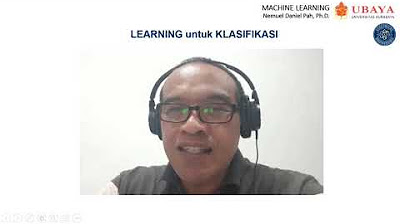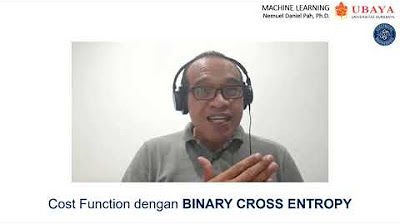Deep Learning(CS7015): Lec 2.5 Perceptron Learning Algorithm
Summary
TLDRThe video script discusses the Perceptron Learning Algorithm, a foundational machine learning technique for binary classification. It revisits a movie rating example to illustrate the algorithm's process of learning weights and threshold from data. The script explains the concept of convergence and the perceptron's goal of correctly classifying data points as positive or negative. It delves into the algorithm's steps, including initializing weights randomly and adjusting them based on errors made during classification. The geometric interpretation of the perceptron's decision boundary and the importance of the dot product in determining the angle between data points and the weight vector are highlighted. The script also addresses potential issues with convergence and the assumption of linearly separable data.
Takeaways
- 📚 The lecture introduces the Perceptron Learning Algorithm, which is a method for learning weights and thresholds in a perceptron model.
- 🎬 The example of movie preferences is used to illustrate the learning process, where past movie data is used to predict whether a new movie will be liked or not.
- 🔢 The data includes various features (variables) that are not just Boolean but can be real numbers, such as a rating between 0 and 1.
- 🤖 The goal of the perceptron is to learn from the data and correctly classify new movies as liked (label 1) or not liked (label 0).
- 🧠 The Perceptron Learning Algorithm starts with random initialization of weights and adjusts them based on the training data to minimize errors.
- 🔄 Convergence in the algorithm is defined as the point when no more errors are made on the training data and predictions do not change.
- 📉 The algorithm involves picking a random data point and adjusting the weights if the prediction is incorrect (error is made).
- 📚 The adjustment of weights involves adding the data point vector to the weight vector if the point is misclassified.
- 📏 The decision boundary is represented by the equation w transpose x = 0, which divides the input space into two halves.
- 📐 The geometric interpretation of the algorithm is that the weight vector w is orthogonal to the decision boundary line.
- 🔍 The algorithm's effectiveness is based on the dot product and the angles between the weight vector and the data points, with adjustments made to ensure correct classification.
Q & A
What is the Perceptron Learning Algorithm?
-The Perceptron Learning Algorithm is a method used to train a perceptron, which is a type of linear classifier. It adjusts the weights of the perceptron iteratively to correctly classify the given data points into two categories, typically represented as positive and negative labels.
What is the purpose of revisiting the movie example in the script?
-The movie example is used to illustrate a more complex scenario where the perceptron has to learn from data that includes both binary and real-valued variables, such as ratings, to classify whether a movie is liked or not.
What does the perceptron model try to achieve with the given data?
-The perceptron model aims to learn the appropriate weights and threshold such that it can correctly classify new, unseen data points based on the training data provided.
How are the weights in the perceptron initialized in the learning algorithm?
-The weights in the perceptron are initialized randomly at the beginning of the learning algorithm. This includes both the weights for the input features and the bias term.
What is meant by 'convergence' in the context of the Perceptron Learning Algorithm?
-Convergence in this context means that the perceptron has learned the weights to an extent where it no longer makes any errors on the training data, or its predictions on the training data do not change with further iterations.
How does the Perceptron Learning Algorithm handle misclassified points?
-If a point is misclassified, i.e., the dot product of the weight vector and the input vector is of the wrong sign, the algorithm adjusts the weight vector by adding the input vector to it, effectively correcting the misclassification.
What is the geometric interpretation of the Perceptron Learning Algorithm?
-Geometrically, the perceptron is trying to find a decision boundary that separates the positive and negative points. This boundary is represented by the line where the dot product of the weight vector and any point on the line equals zero, indicating orthogonality.
Why is the dot product used in the Perceptron Learning Algorithm?
-The dot product is used because it provides a measure of the similarity between two vectors. In the context of the perceptron, it helps determine the classification of a point and the angle between the weight vector and the input vectors.
What is the relationship between the angle formed by the weight vector and the data points, and their classification?
-Data points classified as positive have an angle with the weight vector that is less than 90 degrees, indicating a positive dot product. Conversely, data points classified as negative have an angle greater than 90 degrees, indicating a negative dot product.
Why might the Perceptron Learning Algorithm not converge in some cases?
-The algorithm might not converge if the data is not linearly separable, meaning there is no single hyperplane that can separate all positive and negative points without error.
What is the final step in the Perceptron Learning Algorithm?
-The final step is to make a pass over the data and check if any further corrections are needed. If no corrections are made, indicating that all points are correctly classified, the algorithm has converged and can be stopped.
Outlines

This section is available to paid users only. Please upgrade to access this part.
Upgrade NowMindmap

This section is available to paid users only. Please upgrade to access this part.
Upgrade NowKeywords

This section is available to paid users only. Please upgrade to access this part.
Upgrade NowHighlights

This section is available to paid users only. Please upgrade to access this part.
Upgrade NowTranscripts

This section is available to paid users only. Please upgrade to access this part.
Upgrade Now5.0 / 5 (0 votes)





